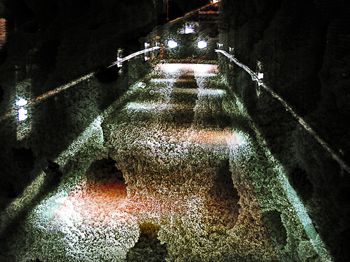Friday, February 23, 2007
Picture of the day
From NanoArt 2006. © Copyright Joe Nalven (click to see larger version)
NANOART is a new art discipline related to micro/nanosculptures created by artists/scientists through chemical/physical processes and/or natural micro/nanostructures that are visualized with powerful research tools like Scanning Electron Microscope and Atomic Force Microscope.
NanoArt could be for the 21st Century what Photography was for the 20th Century. We live in a technological society, in a new Renaissance period, and there is no reason for Arts to stay away from Technology. NanoArt is the expression of the New Technological Revolution and reflects the transition from Science to Art using Technology.
See all of Joe Nalven's NanoArt 2006 entries here, or visit his website.
Please contact me if you would like to submit an image. (rocky at bir-consulting.com)
Quote of the day
"... only about half of Americans have heard anything about nanotechnology. Much has been made of the potential nanotech risks, from uncontrollable nanorobots to the breathing in of nanoparticles. Not surprisingly, public fears are directly correlated with the amount of knowledge that people have about nanotech: the less knowledge, the more fear."
~Stacy Lawrence
~Stacy Lawrence
The disruptive innovations that should arise from nanotechnology over the next decade could be as significant as electricity or the microchip. They could give rise to a whole new set of industries as well as transform current technologies in manufacturing, healthcare, electronics and communications. It has been estimated that the sales of products incorporating emerging nanotechnologies will rise from 0.1% of global manufacturing output in 2004 to 15% in 2014, totalling $2.6 trillion.
~From Nanotechnology: enabling technologies for Australian innovative industries
~From Nanotechnology: enabling technologies for Australian innovative industries
FutureCar, Pt III
Another series of made for TV programs from the Discovery Channel, FutureCar examines today’s technologies and designs and how they might lead to tomorrow’s vehicles.
Today I watched the third of 4 programs (I had previously thought that there were only three parts), this one titled “The Fuel.” The program covered these technologies:
Bio-diesel
Ethanol
Hybrids
Hydrogen/fuel cell (could also power your home)
Hydrogen-electric
Hydrogen-solar
Electric
Solar
Compressed air
And featured these future vehicles:
GM Skateboard (link), with interchangeable bodies and powered by a fuel cell
Aero X (link), which will use 100% ethanol fuel
Attack (link), biodiesel powered, soon to be hybridized with an electric motor
Tesla (link), an electric car, capable of 0 – 6- mph in ~4 seconds, with a 250 mile range. Costs ~$5 to recharge.
t-zero (link), also electric
MDI (link), powered by compressed air
Eclectic, solar powered
As was the case with the previous two programs, car enthusiasts will love this show, as will those that study the future.
Nanotechnology is not explicitly mentioned this time. As with the previous program, many technologies covered in this program will be enabled by nanotechnologies, and all of them enhanced, especially the fuel cell and composite materials.
Bottom line: worth the watch.
Next week I will cover the fourth in the series titled “The Brain.”
To learn more, visit discovery.com/futurecar
Today I watched the third of 4 programs (I had previously thought that there were only three parts), this one titled “The Fuel.” The program covered these technologies:
Bio-diesel
Ethanol
Hybrids
Hydrogen/fuel cell (could also power your home)
Hydrogen-electric
Hydrogen-solar
Electric
Solar
Compressed air
And featured these future vehicles:
GM Skateboard (link), with interchangeable bodies and powered by a fuel cell
Aero X (link), which will use 100% ethanol fuel
Attack (link), biodiesel powered, soon to be hybridized with an electric motor
Tesla (link), an electric car, capable of 0 – 6- mph in ~4 seconds, with a 250 mile range. Costs ~$5 to recharge.
t-zero (link), also electric
MDI (link), powered by compressed air
Eclectic, solar powered
As was the case with the previous two programs, car enthusiasts will love this show, as will those that study the future.
Nanotechnology is not explicitly mentioned this time. As with the previous program, many technologies covered in this program will be enabled by nanotechnologies, and all of them enhanced, especially the fuel cell and composite materials.
Bottom line: worth the watch.
Next week I will cover the fourth in the series titled “The Brain.”
To learn more, visit discovery.com/futurecar
Subscribe to:
Comments (Atom)










